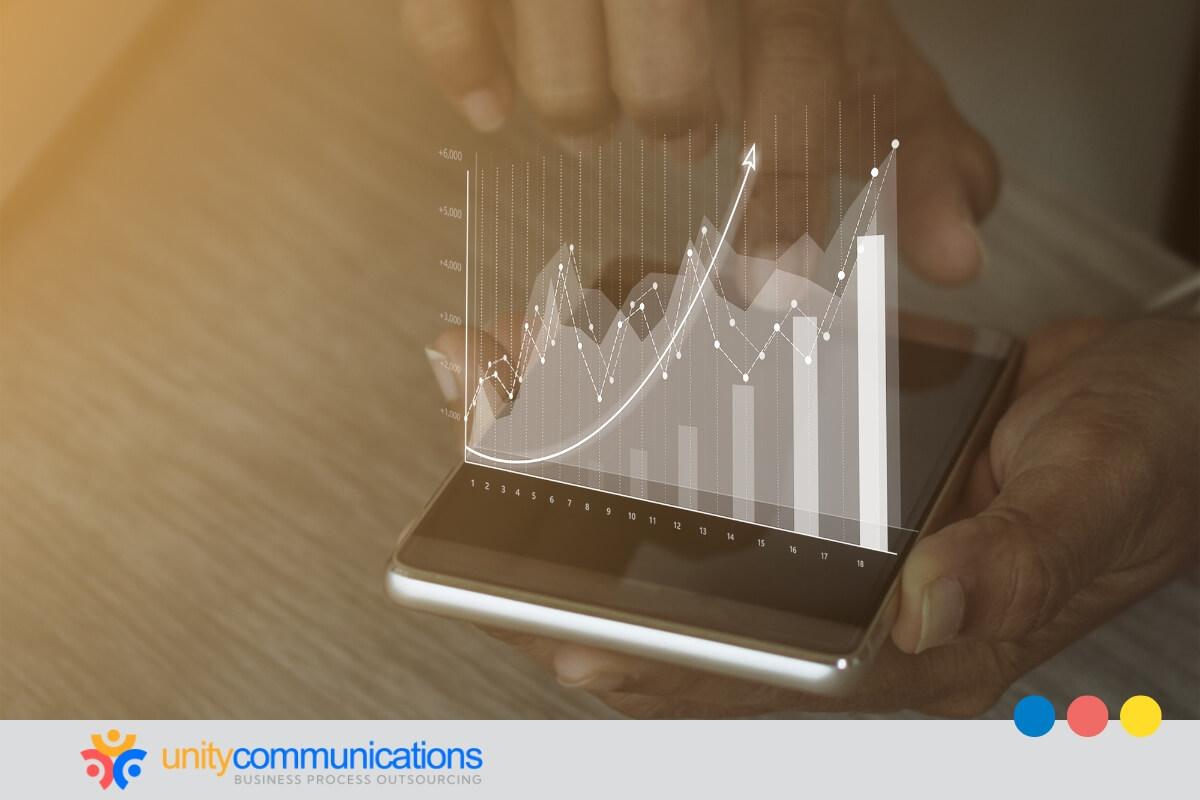Table of Contents
For small businesses, investing in social media marketing services can boost brand awareness, increase customer engagement, and even drive sales. But how do you know if those efforts are paying off?
This is where measuring social media return on investment (ROI) becomes crucial. It informs your decisions, budget, and growth. To make the process easier, consider working with business process outsourcing (BPO) providers who can help with content creation, data analysis, and campaign management at a lower cost.
This article examines how to measure social media ROI and optimize the impact of your marketing efforts, including when collaborating with external experts. Read below to learn more.
4 Proven strategies to improve social media marketing ROI

Social media ROI indicates whether your marketing efforts yield a tangible value for the business. Without it, you spend time, money, and energy on ineffective strategies.
About 64% of marketers say they can confidently measure the ROI of their social media activities. That means many businesses are missing out on critical insights that could optimize their strategy and improve results.
When you understand what’s working (and what’s not), you can:
- Allocate your budget more effectively.
- Focus on high-performing platforms and content.
- Justify your marketing spend to stakeholders or investors.
- Identify areas where business process outsourcing can increase efficiency.
- Refine your messaging to better match audience preferences.
- Set more realistic and data-driven goals for future campaigns.
- Spot trends early and adapt your strategy before competitors do.
Understanding what drives results and what doesn’t is the key to making smarter, more profitable decisions. When you track the right insights, you can fine-tune your strategy, boost performance, and stay ahead of the competition.
Let’s break down four proven strategies to help you measure and improve your social media marketing ROI.
Consider these best practices:
1. Set clear, data-driven goals for your campaigns
With over 5.24 billion users worldwide, social media can quickly expand your reach. However, you need clear, specific objectives to capitalize on this opportunity. Ask yourself: What do you hope to achieve?
- Are you trying to boost brand awareness?
- Do you wish to drive more traffic to your website?
- Are you looking to generate leads or sales?
- Do you want to improve customer service or retention?
Clear, specific objectives are the foundation of your strategy. They guide your content and define your success metrics and the kind of social media ROI you want.
The most effective social media objectives should align directly with your broader business goals to see real, measurable outcomes. You can use the SMART framework to achieve this:
- Specific: Define the goal clearly.
- Measurable: Use metrics to track performance.
- Achievable: Set realistic targets based on your resources.
- Relevant: Align goals with broader business objectives.
- Time-bound: Set a deadline to track progress.
Suppose a brand-new skincare company wants to increase its number of followers. Instead of saying “Increase following,” a SMART objective could be to “Grow Instagram followers by 15% in three months by running a monthly giveaway, collaborating with two micro-influencers, and posting three skincare tips weekly using branded hashtags.”
Another way to set goals is to know your current performance to establish a baseline. This helps track your progress more accurately and set realistic targets. For instance, based on industry benchmarks, if your current average engagement rate is 2%, you might aim for a 3% increase over the next quarter.
If you’re outsourcing social media management, align objectives and key performance indicators (KPIs) early on to ensure both parties work toward the same goals.
2. Choose the right KPIs to measure what matters
After setting clear social media ad campaign goals, you must identify and track the right metrics. Metrics are the building blocks for calculating your social media ROI, letting you know what’s working, what’s not, and how to improve your strategy.
This step is crucial, considering social media is now the preferred product discovery channel among Gen Z and millennials. Tracking the correct data connects you to what resonates with your audience and helps refine your strategy to drive meaningful engagement.
Each business goal has a specific key KPI tied to it. The more a metric ties to your business objective, the easier it is to calculate the returns. Here’s a quick reference:
| Goal | Recommended KPI |
|---|---|
| Brand awareness | Reach, impressions, follower growth, and video views |
| Website traffic | Click-through rate (CTR), referral traffic (Google Analytics), and bounce rate |
| Lead generation | Number of leads, cost per lead (CPL), and sign-up form completions |
| Sales and revenue | Conversion rate, cost per acquisition (CPA), and total revenue from social media |
| Engagement | Likes, shares, comments, saves, and engagement rate |
| Customer support | Response time, resolution rate, and customer satisfaction (CSAT) |
You must also use the right tracking tools to get accurate data on your social media ROI. You can use a combination of the following:
- Social media platform insights such as Facebook Business Suite, Instagram Insights, LinkedIn Analytics, X Analytics, and TikTok Analytics for tracking audience demographics, post performance, engagement metrics, and follower growth
- Google Analytics for tracking website visits, conversions, and traffic sources from social channels
- UTM parameters for measuring the effectiveness of individual posts or campaigns
- Email tools such as HubSpot, Mailchimp, or Salesforce for identifying leads and conversions from social efforts
- Social media management tools such as Hootsuite, Sprout Social, or Buffer for advanced reporting using dashboards
If outsourcing social media marketing, ensure you have shared access to these reports or receive regular analytics updates. Also, establish a weekly or monthly schedule to review your performance. Consistent tracking lets you identify trends, adjust campaigns quickly, and prevent budget waste.
Don’t be distracted by vanity metrics, which don’t align with your goals. Focus on those that lead to action, such as clicks, conversions, or revenue.
Your social media ROI calculation will not reflect the actual impact of your campaign when you don’t measure the right metrics.
3. Calculate the total social media investment
The next step is calculating your total investment. This step focuses on the costs of achieving your social media ROI equation, helping you understand whether your efforts are financially worthwhile.
Your social media investment includes more than ad spend. It’s the complete value of the time, tools, and resources you put into a campaign.
Start with the most obvious: How much did you spend on paid promotions? Track spending per campaign to link it directly with performance. Some examples are:
- Facebook and Instagram ads
- TikTok or YouTube paid campaigns
- Boosted posts or influencer collaborations
- LinkedIn ads (especially for B2B campaigns)
Labor is also a significant investment, whether you manage or outsource social media. Here’s how to calculate that:
- In-house team: Identify the hours spent on content creation, scheduling, monitoring, and reporting. Multiply by the hourly rate or salary percentage.
- Freelancers or agencies: Use the invoice amount or retainer fees.
- BPO: Determine the cost of external support, such as content production, community management, or reporting.
Also include any monthly or annual subscriptions to tools that support your campaign. If you use the platforms across channels, divide the cost proportionally. Include:
- Scheduling tools (e.g., Buffer, Hootsuite, Later)
- Design tools (e.g., Canva, Adobe Creative Suite)
- Analytics and CRM tools (e.g., Sprout Social, Google Analytics, HubSpot)
If you produce original content, include costs for photography or videography, graphic design, copywriting, and stock assets or music licenses. You must also consider additional resources, such as influencer marketing fees, content prizes, and giveaways.
4. Determine the return to complete the ROI equation
After calculating your investment, you need to know what you’ve received in return. Social media ROI depends on your campaign goals. Here’s a guide:
| Goal | Type of return | Examples |
|---|---|---|
| Sales | Revenue | Purchases directly attributed to a campaign |
| Lead generation | Lead value | Number of qualified leads × average lead value |
| Website traffic | Potential revenue | Conversions from website visitors (e.g., signups, downloads) |
| Brand awareness | Estimated value | Value of increased reach or engagement over time |
| Engagement | Long-term value | Repeat interactions that may lead to future sales or loyalty |
You need to link results directly to your campaign to accurately measure ROI and ensure you track only what your social efforts influenced.
You can use:
- UTM parameters in your social links (trackable in Google Analytics)
- Conversion tracking tools (e.g., Facebook Pixel or LinkedIn Insight Tag)
- Customer relationship management (CRM) systems to trace leads and revenue from social interactions
- Promo codes or affiliate links tied to social platforms
Once you have identified the outcomes, assign a financial value to each. You can use the revenue generated from social media conversions for direct sales. For leads, estimate based on your average lead-to-customer conversion rate and average customer value.
For example: 20 leads × 25% close rate × $400 average sale = $2,000 estimated return
Finally, you can measure the value based on historical campaign performance or compare it to paid advertising rates to measure engagement and reach.
Always match your return to your investment’s timeframe and campaign scope. If your campaign ran for four weeks, measure only the ROI within or immediately after that.
Here’s a final example. Let’s say your campaign goal was lead generation:
- You spent $600 on an investment.
- You generated 30 leads.
- Your average customer value is $200.
- Your lead-to-customer conversion rate is 20%.
Return = 30 leads × 20% × $200 = $1,200
ROI = ($1,200 – $600) / $600 × 100 = 100%
That’s a solid return—you doubled your money. By assigning value to your campaign results and tying them directly to your original investment, you complete the ROI equation with confidence and clarity. This final step reveals whether your efforts truly delivered impact or need refinement.
Now that you understand how to measure ROI, it’s time to use those insights to sharpen your strategy and boost your returns even further.
The bottom line

Measuring social media ROI is more than tracking numbers. You also must align marketing efforts with tangible business outcomes. When you set clear objectives, track the right metrics, and calculate your investment and return, you can justify your social media spending and refine your strategy for better results.
Remember that the key to success is constant evaluation and optimization. What works today might evolve. Measuring social media ROI lets you stay ahead of the curve.
Want to boost your social media ROI without stretching your team thin? Partner with a trusted BPO provider to streamline your strategy, reduce costs, and drive measurable results. Let’s connect and turn your marketing into a real growth engine.



